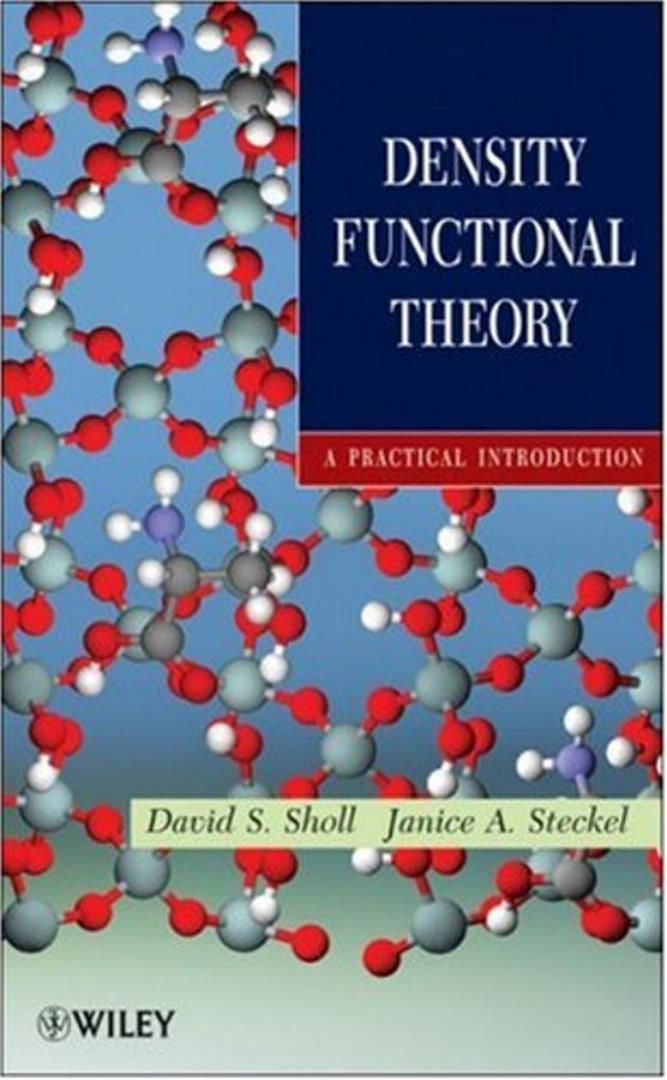
DENSITY FUNCTIONAL THEORY A PRACTICAL INTRODUCTION David S.Sholl lanice A.Steckel WILEY
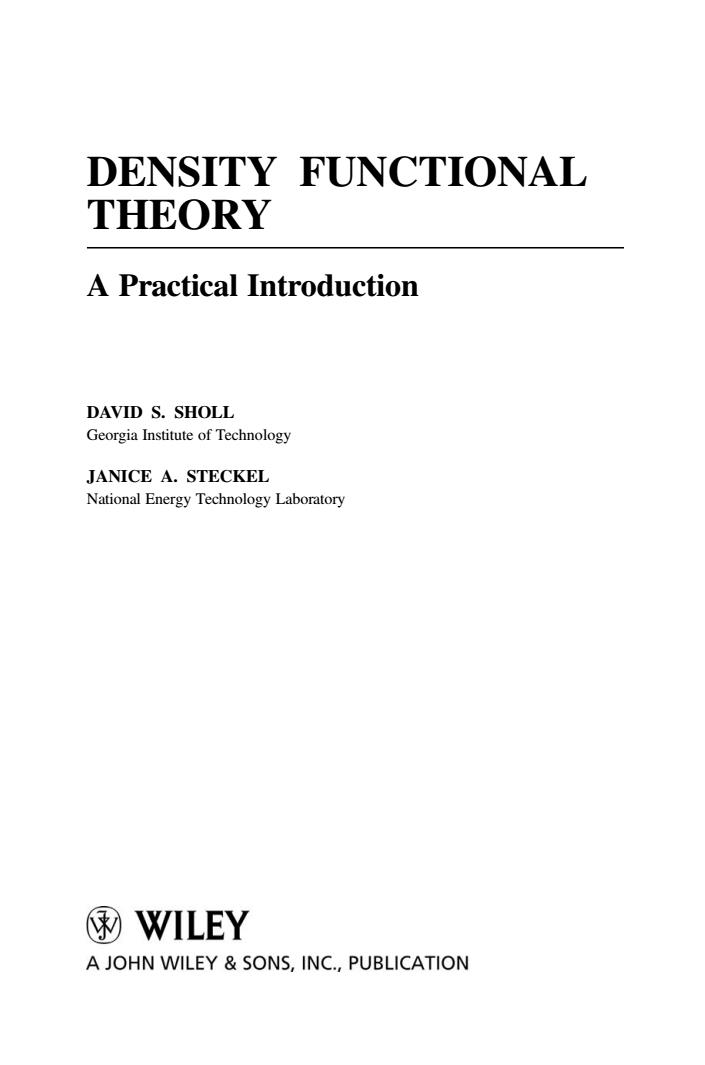
DENSITY FUNCTIONAL THEORY A Practical Introduction DAVID S.SHOLL Georgia Institute of Technology JANICE A.STECKEL National Energy Technology Laboratory WILEY A JOHN WILEY SONS,INC.,PUBLICATION
DENSITY FUNCTIONAL THEORY A Practical Introduction DAVID S. SHOLL Georgia Institute of Technology JANICE A. STECKEL National Energy Technology Laboratory
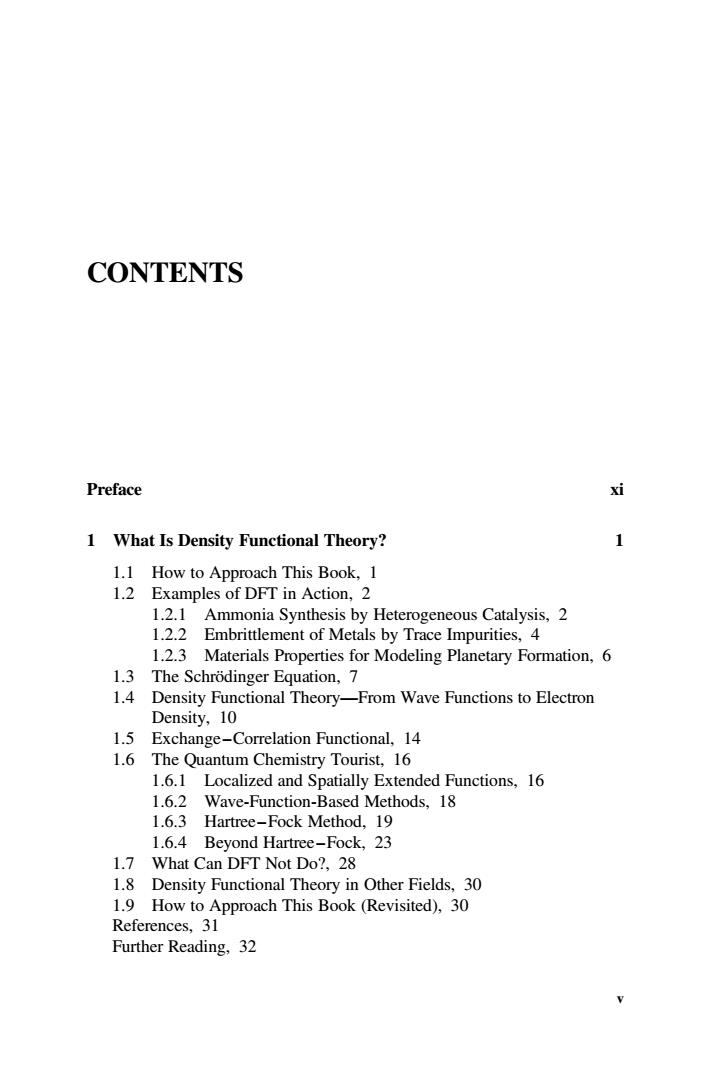
CONTENTS Preface xi 1 What Is Density Functional Theory? 1 1.1 How to Approach This Book,1 1.2 Examples of DFT in Action,2 1.2.1 Ammonia Synthesis by Heterogeneous Catalysis,2 1.2.2 Embrittlement of Metals by Trace Impurities,4 1.2.3 Materials Properties for Modeling Planetary Formation,6 1.3 The Schrodinger Equation,7 1.4 Density Functional Theory-From Wave Functions to Electron Density,10 1.5 Exchange-Correlation Functional,14 1.6 The Quantum Chemistry Tourist,16 1.6.1 Localized and Spatially Extended Functions,16 1.6.2 Wave-Function-Based Methods,18 1.6.3 Hartree-Fock Method,19 1.6.4 Beyond Hartree-Fock,23 1.7 What Can DFT Not Do?,28 1.8 Density Functional Theory in Other Fields,30 1.9 How to Approach This Book (Revisited),30 References,31 Further Reading,32
CONTENTS Preface xi 1 What Is Density Functional Theory? 1 1.1 How to Approach This Book, 1 1.2 Examples of DFT in Action, 2 1.2.1 Ammonia Synthesis by Heterogeneous Catalysis, 2 1.2.2 Embrittlement of Metals by Trace Impurities, 4 1.2.3 Materials Properties for Modeling Planetary Formation, 6 1.3 The Schro¨dinger Equation, 7 1.4 Density Functional Theory—From Wave Functions to Electron Density, 10 1.5 Exchange –Correlation Functional, 14 1.6 The Quantum Chemistry Tourist, 16 1.6.1 Localized and Spatially Extended Functions, 16 1.6.2 Wave-Function-Based Methods, 18 1.6.3 Hartree –Fock Method, 19 1.6.4 Beyond Hartree –Fock, 23 1.7 What Can DFT Not Do?, 28 1.8 Density Functional Theory in Other Fields, 30 1.9 How to Approach This Book (Revisited), 30 References, 31 Further Reading, 32 v
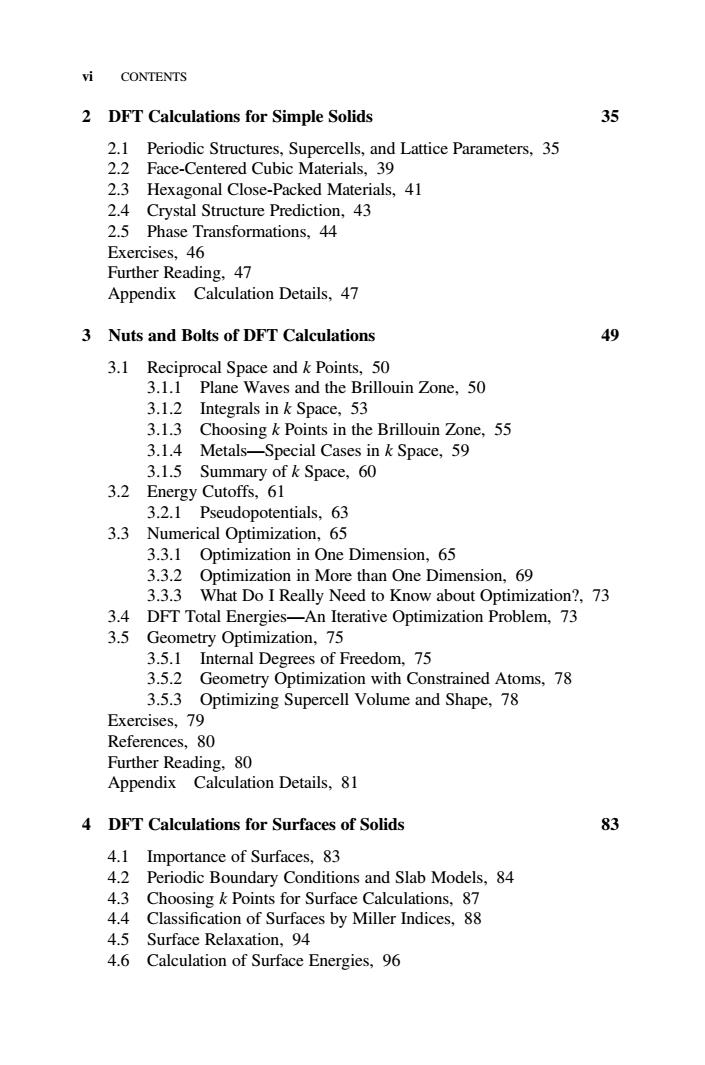
i CONTENTS 2 DFT Calculations for Simple Solids 35 2.1 Periodic Structures,Supercells,and Lattice Parameters,35 2.2 Face-Centered Cubic Materials,39 2.3 Hexagonal Close-Packed Materials,41 2.4 Crystal Structure Prediction,43 2.5 Phase Transformations,44 Exercises,46 Further Reading,47 Appendix Calculation Details,47 3 Nuts and Bolts of DFT Calculations 49 3.1 Reciprocal Space and k Points,50 3.1.1 Plane Waves and the Brillouin Zone,50 3.1.2 Integrals in k Space,53 3.1.3 Choosing k Points in the Brillouin Zone,55 3.1.4 Metals-Special Cases in k Space,59 3.1.5 Summary of k Space,60 3.2 Energy Cutoffs,61 3.2.1 Pseudopotentials,63 3.3 Numerical Optimization,65 3.3.1 Optimization in One Dimension,65 3.3.2 Optimization in More than One Dimension,69 3.3.3 What Do I Really Need to Know about Optimization?,73 3.4 DFT Total Energies-An Iterative Optimization Problem,73 3.5 Geometry Optimization,75 3.5.1 Internal Degrees of Freedom,75 3.5.2 Geometry Optimization with Constrained Atoms,78 3.5.3 Optimizing Supercell Volume and Shape,78 Exercises,79 References,80 Further Reading,80 Appendix Calculation Details,81 4 DFT Calculations for Surfaces of Solids 83 4.1 Importance of Surfaces,83 4.2 Periodic Boundary Conditions and Slab Models,84 4.3 Choosing k Points for Surface Calculations,87 4.4 Classification of Surfaces by Miller Indices,88 4.5 Surface Relaxation,94 4.6 Calculation of Surface Energies,96
2 DFT Calculations for Simple Solids 35 2.1 Periodic Structures, Supercells, and Lattice Parameters, 35 2.2 Face-Centered Cubic Materials, 39 2.3 Hexagonal Close-Packed Materials, 41 2.4 Crystal Structure Prediction, 43 2.5 Phase Transformations, 44 Exercises, 46 Further Reading, 47 Appendix Calculation Details, 47 3 Nuts and Bolts of DFT Calculations 49 3.1 Reciprocal Space and k Points, 50 3.1.1 Plane Waves and the Brillouin Zone, 50 3.1.2 Integrals in k Space, 53 3.1.3 Choosing k Points in the Brillouin Zone, 55 3.1.4 Metals—Special Cases in k Space, 59 3.1.5 Summary of k Space, 60 3.2 Energy Cutoffs, 61 3.2.1 Pseudopotentials, 63 3.3 Numerical Optimization, 65 3.3.1 Optimization in One Dimension, 65 3.3.2 Optimization in More than One Dimension, 69 3.3.3 What Do I Really Need to Know about Optimization?, 73 3.4 DFT Total Energies—An Iterative Optimization Problem, 73 3.5 Geometry Optimization, 75 3.5.1 Internal Degrees of Freedom, 75 3.5.2 Geometry Optimization with Constrained Atoms, 78 3.5.3 Optimizing Supercell Volume and Shape, 78 Exercises, 79 References, 80 Further Reading, 80 Appendix Calculation Details, 81 4 DFT Calculations for Surfaces of Solids 83 4.1 Importance of Surfaces, 83 4.2 Periodic Boundary Conditions and Slab Models, 84 4.3 Choosing k Points for Surface Calculations, 87 4.4 Classification of Surfaces by Miller Indices, 88 4.5 Surface Relaxation, 94 4.6 Calculation of Surface Energies, 96 vi CONTENTS
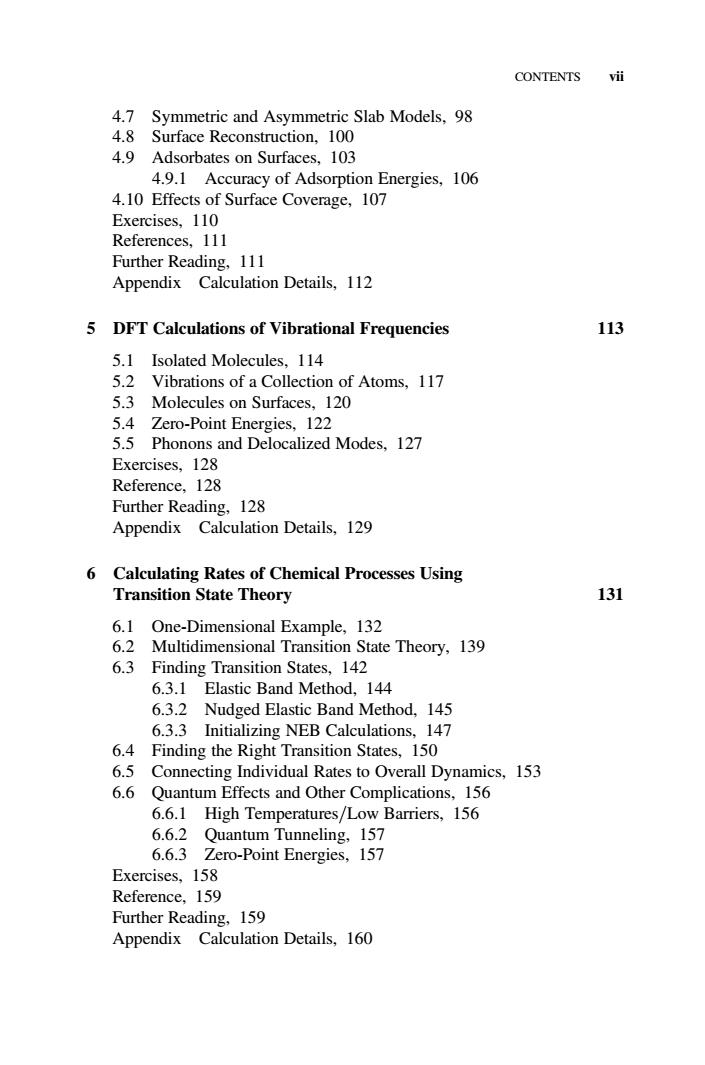
CONTENTS vii 4.7 Symmetric and Asymmetric Slab Models,98 4.8 Surface Reconstruction,100 4.9 Adsorbates on Surfaces,103 4.9.1 Accuracy of Adsorption Energies,106 4.10 Effects of Surface Coverage,107 Exercises,110 References,111 Further Reading,111 Appendix Calculation Details,112 5 DFT Calculations of Vibrational Frequencies 113 5.1 Isolated Molecules,114 5.2 Vibrations of a Collection of Atoms,117 5.3 Molecules on Surfaces,120 5.4 Zero-Point Energies,122 5.5 Phonons and Delocalized Modes,127 Exercises,128 Reference,128 Further Reading,128 Appendix Calculation Details,129 6 Calculating Rates of Chemical Processes Using Transition State Theory 131 6.1 One-Dimensional Example,132 6.2 Multidimensional Transition State Theory,139 6.3 Finding Transition States,142 6.3.1 Elastic Band Method,144 6.3.2 Nudged Elastic Band Method,145 6.3.3 Initializing NEB Calculations,147 6.4 Finding the Right Transition States,150 6.5 Connecting Individual Rates to Overall Dynamics,153 6.6 Quantum Effects and Other Complications,156 6.6.1 High Temperatures/Low Barriers,156 6.6.2 Quantum Tunneling,157 6.6.3 Zero-Point Energies,157 Exercises,158 Reference,159 Further Reading,159 Appendix Calculation Details,160
4.7 Symmetric and Asymmetric Slab Models, 98 4.8 Surface Reconstruction, 100 4.9 Adsorbates on Surfaces, 103 4.9.1 Accuracy of Adsorption Energies, 106 4.10 Effects of Surface Coverage, 107 Exercises, 110 References, 111 Further Reading, 111 Appendix Calculation Details, 112 5 DFT Calculations of Vibrational Frequencies 113 5.1 Isolated Molecules, 114 5.2 Vibrations of a Collection of Atoms, 117 5.3 Molecules on Surfaces, 120 5.4 Zero-Point Energies, 122 5.5 Phonons and Delocalized Modes, 127 Exercises, 128 Reference, 128 Further Reading, 128 Appendix Calculation Details, 129 6 Calculating Rates of Chemical Processes Using Transition State Theory 131 6.1 One-Dimensional Example, 132 6.2 Multidimensional Transition State Theory, 139 6.3 Finding Transition States, 142 6.3.1 Elastic Band Method, 144 6.3.2 Nudged Elastic Band Method, 145 6.3.3 Initializing NEB Calculations, 147 6.4 Finding the Right Transition States, 150 6.5 Connecting Individual Rates to Overall Dynamics, 153 6.6 Quantum Effects and Other Complications, 156 6.6.1 High Temperatures/Low Barriers, 156 6.6.2 Quantum Tunneling, 157 6.6.3 Zero-Point Energies, 157 Exercises, 158 Reference, 159 Further Reading, 159 Appendix Calculation Details, 160 CONTENTS vii